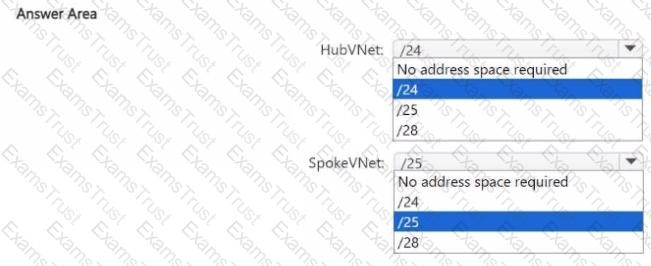For each of the following statements, select Yes if the statement is true. Otherwise, select No.
NOTE: Each correct selection is worth one point.

You are implementing the Virtual network requirements for Vnet6.
What is the minimum number of subnets and service endpoints you should create? To answer, select the appropriate options in the answer area.
NOTE: Each correct selection is worth one point.

For each of the following statements, select Yes if the statement is true. Otherwise, select No.
NOTE: Each correct selection is worth one point.

You need to meet the network security requirements for the NSG flow logs.
Which type of resource do you need, and how many instances should you create? To answer, select the appropriate options in the answer area.
NOTE: Each correct selection is worth one point.

You create NSG10 and NSG11 to meet the network security requirements.
For each of the following statements, select Yes it the statement is true. Otherwise, select No.
NOTE: Each correct selection is worth one point.

You are implementing the virtual network requirements for VM Analyze.
What should you include in a custom route that is linked to Subnet2? To answer, select the appropriate options in the answer area.
NOTE: Each correct selection is worth one point.
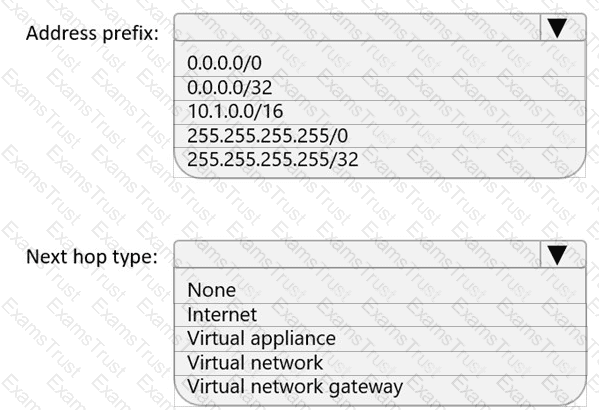
You need to configure GW1 to meet the network security requirements for the P2S VPN users.
Which Tunnel type should you select in the Point-to-site configuration settings of GW1?
In which NSGs can you use ASG1 and to which virtual machine network interfaces can you associate ASG1? To answer, select the appropriate options in the answer area.
NOTE: Each correct selection is worth one point.

What should you implement to meet the virtual network requirements for the virtual machines that connect to Vnet4 and Vnet5?
Which virtual machines can VM1 and VM4 ping successfully? To answer, select the appropriate options in the answer area.
NOTE: Each correct selection is worth one point.
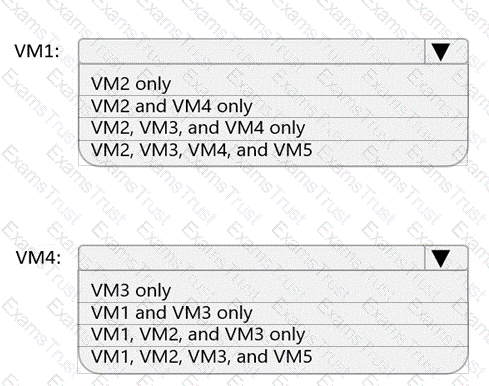
You have an Azure subscription that contains a virtual network named VNet1. VNet1 uses an IP address space of 192.168.0.0/24. You plan to deploy Azure virtual machines and Azure Bastion to VNet1.
You need to recommend an IP subnetting configuration for VNet1. The solution must maximize the number of IP addresses that can be assigned to the virtual machines
What should you recommend? To answer, select the appropriate options in the answer area.
NOTE: Each correct selection is worth one point.

You have two Azure virtual networks named VNet1 and VNet2 that are peered with each other. VNet1 hosts 10 virtual machines that contain web servers. VNet2 hosts five virtual machines that contain database servers.
You need to configure a security solution that meets the following requirements:
• Ensures that the database servers can accept connections only from the web servers
• Ensures that the web servers can initiate connections only to the database servers
• Ensures that all network security groups (NSGs) are associated only with subnets
• Use application security groups to implement the solution
What is the minimum number of application security groups required?
You have an on premises web server that hosts a web app named App1 and has the following configurations:
• IP address 131.107.50.60
• FQDN server1.contoso.com
You have an Azure subscription.
You need to publish App1 by using Azure Front Door. The solution must meet the following requirements:
• Ensure that internet users can connect to App1 by using an FQDN of appl.contoso.com.
• Minimize the changes required to the configuration of Front Door if Server 1 is migrated to Azure.
What should you include in the solution? To answer, select the appropriate options in the answer area.
NOTE: Each correct selection is worth one point.

Your on-premises network uses an IP address range of 10.1.0.0 to 10.1.255.255.
You plan to deploy a new Azure virtual network solution that will include the following elements:
• A virtual network named VNet1
• A Site-to-Site (S2S) VPN connection between VNet1 and the on-premises network
• GatewaySubnet in VNet1, which will be used as a route-based virtual network gateway
You need to recommend which subnet masks to assign to VNet1 and GatewaySubnet. The solution must meet the following requirements:
• Maximize the number of available IP addresses on VNet1.
• Minimize the number of available IP addresses on GatewaySubnet
Which address spaces should you assign to VNet1 and GatewaySubnet? To answer, select the appropriate options in the answer area.
NOTE: Each correct selection is worth one point.
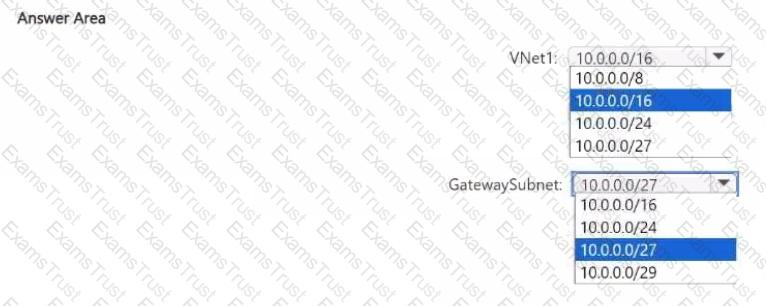
You have an Azure subscription that contains the resources shown in the following table.

You need to ensure that VM1 and VM2 can connect only to storage1. The solution must meet the following requirements:
• Prevent VM1 and VM2 from accessing any other storage accounts.
• Ensure that storage1 is accessible from the internet.
What should you use?
You have an Azure subscription that contains the resources shown in the following table.

You establish BGP peering between NVA1 and Hub1.
You need to implement transit connectivity between VNet1 and VNet3 via Hub1 by using BGP peering. The solution must minimize costs.
What should you do? To answer, select the appropriate options in the answer area.
NOTE: Each correct selection is worth one point.

You have an Azure subscription that contains an app named Appl. App1 is hosted on the Azure App Service instances shown in the following table.

You need to implement Azure Traffic Manager to meet the following requirements:
• App1 traffic must be assigned equally to each App Service instance in each Azure region.
• App1 traffic from North Europe must be routed to the Appl instances in the North Europe region.
• App1 traffic from North America must be routed to the Appl instances in the East US Azure region.

Your company has offices in Montreal. Seattle, and Paris. The outbound traffic from each office originates from a specific public IP address.
You create an Azure Front Door instance named FD1 that has Azure Web Application Firewall (WAF) enabled. You configure a WAF policy named Policy! that has a rule named Rule1. Rule1 applies a rate limit of 100 requests for traffic that originates from the office in Montreal.
You need to apply a rate limit of 100 requests for traffic that originates from each office.
What should you do?
You configure a route table named RT1 that has the routes shown in the following table.

You have an Azure virtual network named Vnet1 that has the subnets shown in the following table.

You have the resources shown in the following table.

Vnet1 connects to an ExpressRoute circuit. The on-premises router advertises the following routes:
* 0.0.0.0/0
* 10.0.0.0/16
For each of the following statements, select Yes if the statement is true. Otherwise, select No. NOTE: Each correct selection is worth one point.

Task 3
You plan to implement an Azure application gateway in the East US Azure region. The application gateway will have Web Application Firewall (WAF) enabled.
You need to create a policy that can be linked to the planned application gateway. The policy must block connections from IP addresses in the 131.107.150.0/24 range. You do NOT need to provision the application gateway to complete this task.
Task 6
You have two servers that are each hosted by a separate service provider in New York and Germany. The server hosted in New York is accessible by using a host name of ny.contoso.com. The server hosted in Germany is accessible by using a host name of de.contoso.com.
You need to provide a single host name to access both servers. The solution must ensure that traffic originating from Germany is routed to de contoso.com. All other traffic must be routed to ny.contoso.com.
Task 9
You need to ensure that subnet4-3 can accommodate 507 hosts.
Task 11
You need to ensure that only hosts on VNET1 can access the slcnage42150372 storage account. The solution must ensure that access occurs over the Azure backbone network.
Task 5
You need to ensure that requests for wwwjelecloud.com from any of your Azure virtual networks resolve to frontdoor1.azurefd.net.
Task 8
You need to ensure that the storage34280945 storage account will only accept connections from hosts on VNET1
Task 3
You need to ensure that hosts on VNET1 and VNET2 can communicate. The solution must minimize latency between the virtual networks.
You have an Azure subscription. The subscription contains an Azure application gateway that has the following configurations:
• Name: AppGW1
• Tier Standard V2
• Autoscaling: Disabled
You create a user named User1.
You need to ensure that User1 can change the tier of AppGW1. The solution must use the principle of least privilege.
Which role should you assign to User1. and to which tiers can AppGW1 be changed? To answer, select the appropriate options in the answer area.
NOTE: Each correct selection is worth one point.
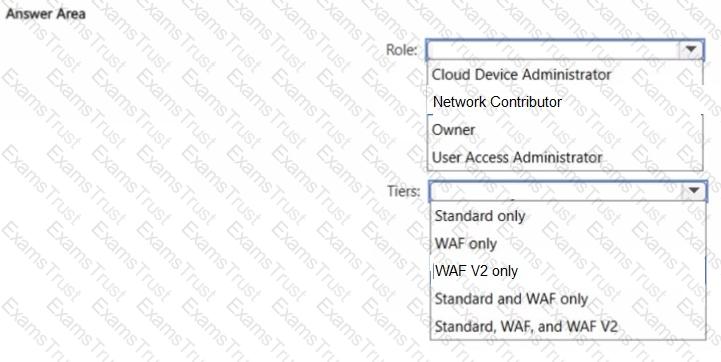
You have an Azure subscription that contains a web app named App1 and an Azure Web Application Firewall (WAF) on Azure Front Door instance named FD1. FD1 manages traffic for App1.
You solution high levels of traffic to App1, the traffic is detected and blocked automatically. The solution must minimize administrative effort.
What should you include in the solution?
Task 9
You plan to use VNET4 for an Azure API Management implementation.
You need to configure a policy that can be used by an Azure application gateway to protect against known web attack vectors. The policy must only allow requests that originate from IP addresses in Canada. You do NOT need to create the application gateway to complete this task.
You have 50 on-premises networks. Each network contains a server that runs Windows Server.
You have an Azure subscription that contains a virtual network named VNet1. VNet1 contains a database server named DB1.
You plan to deploy an app named App1 that will be hosted on the on-premises servers and will connect to DB1 by using Azure Network Adapter.
What should you use to support the Azure Network Adapter connections to VNet1? To answer, select the appropriate options in the answer area.
NOTE: Each correct selection is worth one point.
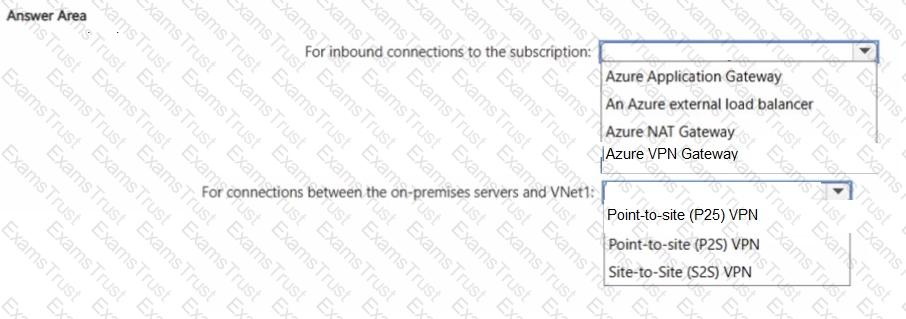
Task 8
You plan to deploy an appliance to subnet3-2- The appliance will perform packet inspection and will have an IP address of 10.3.2.100.
You need to ensure that all traffic to the internet from subnet3-1 is forwarded to the appliance for inspection.
You have an on-premises network.
You have an Azure subscription that contains a virtual network. You have an ExpressRoute service provider.
You plan to connect the Azure virtual network and the on-premises network by using an ExpressRoute circuit. You create a new ExpressRoute circuit. You need to provision the new circuit. Which information should you provide to the service provider?
Task 6
You need to ensure that all hosts deployed to subnet3-2 connect to the internet by using the same static public IP address. The solution must minimize administrative effort when adding hosts to the subnet.
You register a DNS domain with a third-party registrar.
You need to host the DNS zone on Azure.
Which three actions should you perform in sequence? To answer, move the appropriate actions from the list of actions to the answer area and arrange them in the correct order.

Task 1
You plan to deploy a firewall to subnetl-2. The firewall will have an IP address of 10.1.2.4.
You need to ensure that traffic from subnetl-1 to the IP address range of 192.168.10.0/24 is routed through the firewall that will be deployed to subnetl-2. The solution must be achieved without using dynamic routing protocols.
You have an Azure subscription that contains a virtual network named VNetl and the resources shown in the following table.

You need to implement a solution for the traffic onginating from VNetl. The solution must meet the following requirements:
• Perform transparent proxying to external web servers.
• Inspect all outbound TLS traffic.
• Minimize costs.
Which resource should you include in the solution?
Task 4
You need to ensure that the owner of VNET3 receives an alert if an administrative operation is performed on the virtual network.
Task 10
You need to configure VNET1 to log all events and metrics. The solution must ensure that you can query the events and metrics directly from the Azure portal by using KQL.
You need to provide access to storage2. The solution must meet the PaaS networking requirements and the business requirements.
Which connectivity method should you use?
You need to connect Vnet2 and Vnet3. The solution must meet the virtual networking requirements and the business requirements.
Which two actions should you include in the solution? Each correct answer presents part of the solution.
NOTE: Each correct selection is worth one point.
You need to implement outbound connectivity for VMScaleSet1. The solution must meet the virtual networking requirements and the business requirements.
Which three actions should you perform in sequence? To answer, move the appropriate actions from the list of actions to the answer area and arrange them in the correct order.
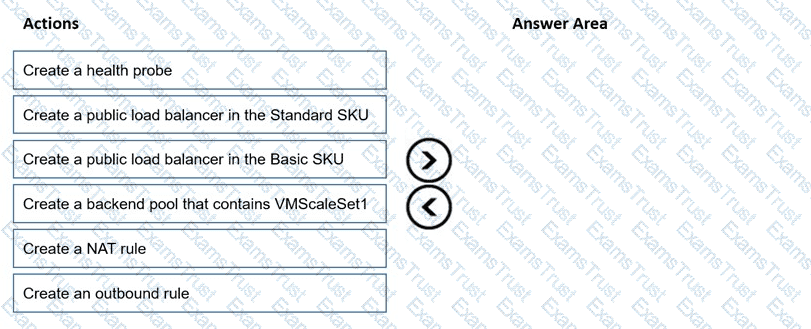
You need to implement name resolution for the cloud.liwareinc.com. The solution must meet the networking requirements.
What should you do? To answer, select the appropriate options in the answer area.
NOTE: Each correct selection is worth one point.

You need to restrict traffic from VMScaleSet1 to VMScaleSet2. The solution must meet the virtual networking requirements.
What is the minimum number of custom NSG rules and NSG assignments required? To answer, select the appropriate options in the answer area.
NOTE: Each correct selection is worth one point.
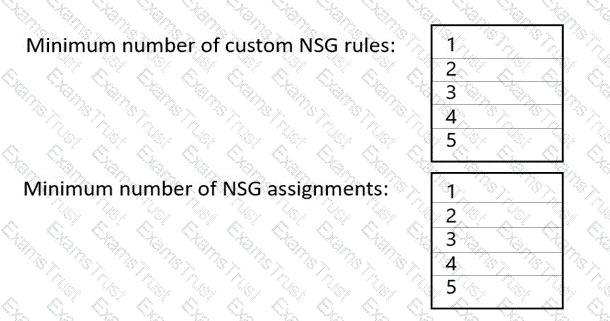
You need to configure the default route in Vnet2 and Vnet3. The solution must meet the virtual networking requirements.
What should you use to configure the default route?
You need to recommend a configuration for the ExpressRoute connection from the Boston datacenter. The solution must meet the hybrid networking requirements and business requirements.
What should you recommend? To answer, select the appropriate options in the answer area.
NOTE: Each correct selection is worth one point.

You need to implement a P2S VPN for the users in the branch office. The solution must meet the hybrid networking requirements.
What should you do? To answer, select the appropriate options in the answer area.
NOTE: Each correct selection is worth one point.

You need to implement outbound connectivity for VMScaleSet1. The solution must meet the virtual networking requirements and the business requirements.
Which three actions should you perform in sequence? To answer, move the appropriate actions from the list of actions to the answer area and arrange them in the correct order.

You need to provide connectivity to storage1. The solution must meet the PaaS networking requirements and the business requirements.
What should you include in the solution?
You need to configure the default route in Vnet2 and Vnet3. The solution must meet the virtual networking requirements.
What should you use to configure the default route?
You need to manage connectivity from NYCNet to the Azure services that use private endpoints. The solution must meet the security requirements. What should you do first?
You need to configure APPGW1 to support end-to-end encryption. The solution must meet the security requirements. What should you do?
You ate configuring the DNS forwarding luleset for DNSR1
You need to configure the destination IP address for azure.proseware.com and for corp.proseware.com. The solution must meet the general requirements.
Which IP addiesses should you configure for each namespace? To answer, select the appropriate options in the answer area.
NOTE: Each correct selection is worth one point.

You need to configure connectivity between NYCNet and SFONet. The solution must meet the connectivity requirements. What should you do? To answer, select the appropriate options in the answer area. NOTE: Each correct selection is worth one point.

You need to configure a security rule for APPGW1-NSG1. The solution must support the planned changes. Which service tag should you use?
You need to configure a custom rule for APPGWI-WAFPolicy to allow only connections that originate from FD1. The solution must support the planned changes.
Which Match type and Match variable should you select?
You need to plan the deployment of LBGW1. The solution must support the planned changes.
What should you include in the solution? To answer, select the appropriate options in the answer area.
NOTE: Each correct selection is worth one point.

You need to identify which IP address space to allocate for the planned deployment of PRDNS1 to HubVNet and SpokeVNet. The solution must meet the general requirements
What should you identify for each virtual network? To answer, select the appropriate options in the answer area. NOTE: Each correct selection is worth one point.
